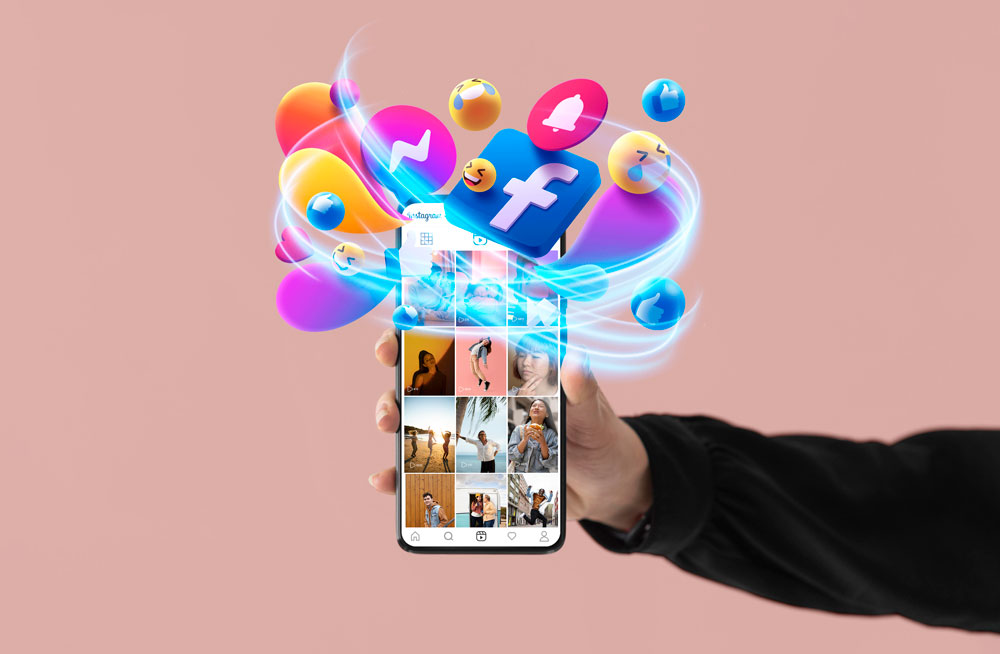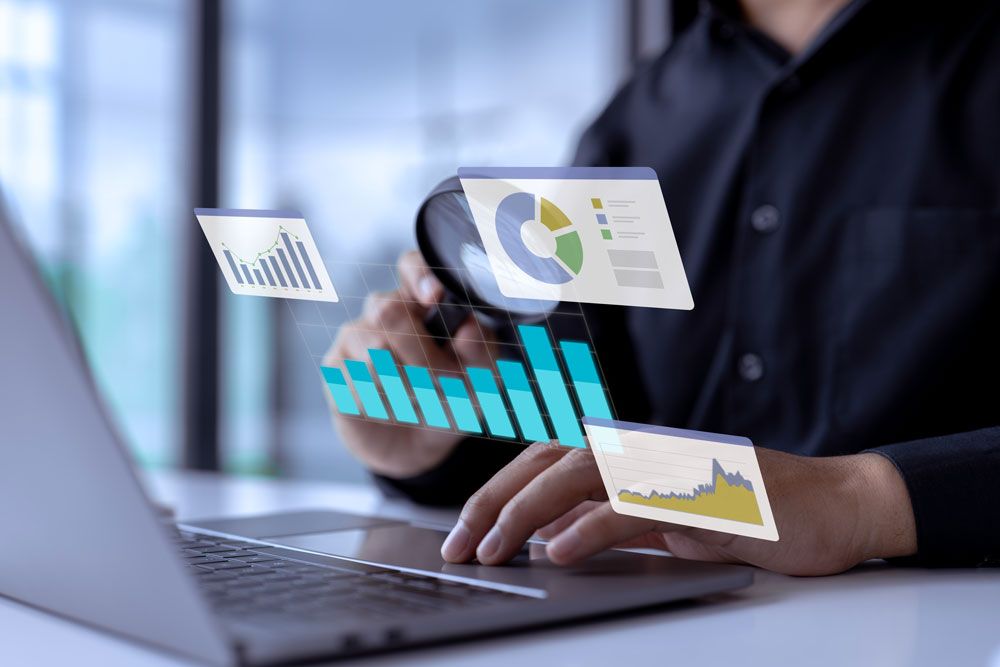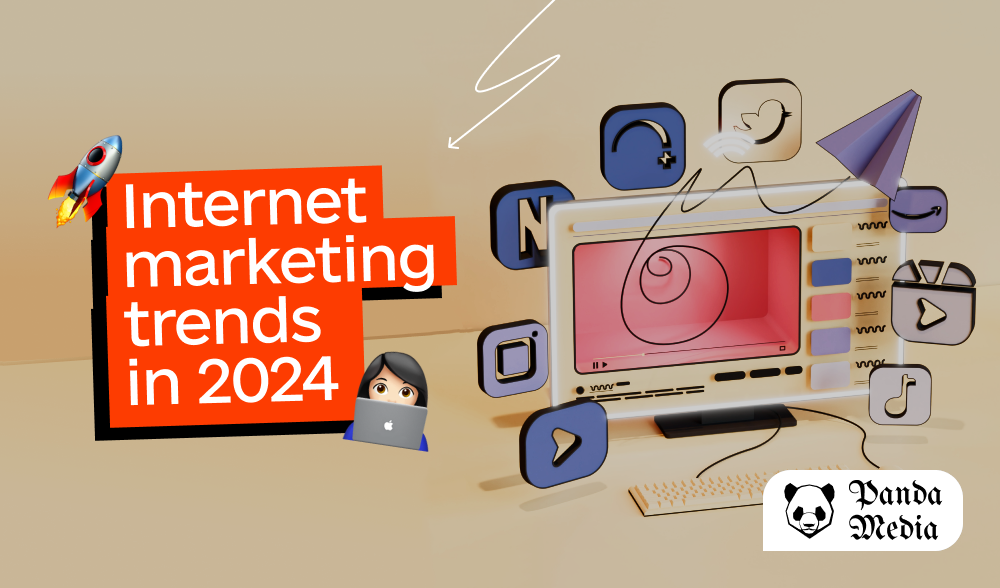In today’s digital world, online marketing is one of the main tools for the development of small and medium-sized businesses. This course will continue to change and adapt to new circumstances, market trends, and changes in consumer behavior in 2024.
There’s a lot to do to succeed in 2024, but if you know the trends that will be coming, it will be easier to plan, strategize, and stay ahead of the competition.
In this article, we’re going to take a look at the digital marketing trends to watch out for in 2024 that we’ve learned from our online marketing experts:
- In the “Social Media” section, we explore the emergence of Instagram Threads; why you should take LinkedIn seriously; and how artificial intelligence will play an increasingly important role on social media platforms.
- Marketing using AI takes into account the marketer’s role in strategy development, the self-learning nature of the technology, the need for new skills, and the importance of co-creation.
- Website optimization strategies focus on preparing for the Google Search Generative Experience (SGE) program, with a particular emphasis on EEAT, user experience value, and valuable shareable content.
- Google Ads encourages us to consider artificial intelligence as an assistant in contextual advertising and avoid pressure from Google representatives to change campaigns.
- Data privacy and security are becoming increasingly important for online marketing strategies.
- When it comes to online marketing careers, 2024 will be an employer’s market, and if AI doesn’t take your job, someone with AI skills will.
Social media trends
It’s going to be another exciting year for social media! In 2024, social media platforms will continue to compete for consumer attention and will have to rethink how they measure success.
There could also be a shift in dominance as the ongoing drama with X (formerly Twitter) leaves room for new platforms like Instagram Threads and Bluesky to grow in popularity, while other networks have the potential to gain new ground for organic traffic.

The popularity of Threads is growing
Meta launched Threads in July 2023 and now claims to have 100 million monthly users, a number that will no doubt continue to grow as the service finally launched in the European Union last week. A competitor and alternative to X, Threads is used primarily to share text updates and join public discussions.
Expert advice: At the very least, brands should have a presence on Threads, even if it’s just a username grab, as the number of users will increase in 2024. Do your research. See how other brands are using it, e.g. Canva, TedTalks. Now is the time to experiment with the platform.
Retention rate – is a new indicator of engagement
In recent years, marketers have seen a decline in engagement rates for organic social media activity. Although there are many reasons for this –- content quality, time of day, device –- in 2024, people may move away from engagement and focus on user retention.
To combat this, brands are creating fantastic social media campaigns built around entertaining, educating, and informing audiences. The key is to drive engagement through playfulness and creativity.
Experts believe that social media platforms are striving to achieve this by testing longer videos. TikTok, for example, will introduce 15-minute uploads – and focusing on how brands not only engage their audience but also retain viewers.
LinkedIn’s organic reach dominates
LinkedIn has just crossed the one billion mark worldwide. That’s a far cry from the days when LinkedIn was just a place to upload resumes and find jobs!
In 2024, thought leaders expect LinkedIn to see significant growth in organic reach, which is rare for social channels today.
Expert Tip: There is a lot of interaction between authors on LinkedIn. You can switch to “Author Mode” on your personal profile, which will enhance your profile and give you access to more tools. In terms of paid media, video ads seem to generate the most engagement on LinkedIn.
Artificial intelligence is integrating into social platforms
It’s no surprise that social media marketers are using artificial intelligence to improve performance. AI tools such as ChatGPT and Midjourney help marketers come up with campaign concepts and ideas for social posts, as well as help create copy and convert text to images.
At the same time, social media platforms are integrating artificial intelligence into their platforms. For example:
- TikTok allows you to customize your feed based on artificial intelligence.
- Instagram is experimenting with AI-generated stickers.
- LinkedIn offers premium users AI features such as AI-assisted profile creation and “Best Jobs” signals.
- YouTube is experimenting with Dream Track for Shorts and Music AI tools.

Artificial Intelligence in Online Marketing Trends
There’s no doubt that artificial intelligence is dominating the headlines and is on the minds of many marketers. In 2024, we predict further exponential growth in AI capabilities, which will require businesses to adopt this technology and stay ahead of the rapidly changing landscape.
“49% of the value of the NASDAQ and 25% of the US stock market is accounted for by just six companies, all of which are in the AI space,” said Brian Korish, founder of AI consulting firm Elemental Intelligence and a DMI Global Champion.
What does this mean for marketers?
Marketing should take ownership of AI strategy
There is some confusion about what to do with AI. Since marketing departments are closest to the customer, they can be proactive and drive the AI strategy. They can use the knowledge gained from customer interactions to identify opportunities that AI can bring to improve what the company already has.
“Marketers have the opportunity to own artificial intelligence because no one currently owns it in companies. It’s a great opportunity for marketers to say, “I’m going to own this and be the person who helped develop the strategy that decides what we’re going to do and how we’re going to best use AI,”– said Ken Fitzpatrick, CEO of the Digital Marketing Institute.
Experts believe that the first step is to identify the type of company you work for, as well as its desire for change and resistance to change. After that, you can strategically identify and prioritize AI projects, getting the necessary support from stakeholders.
When choosing an AI project, marketers should decide whether they want to optimize processes, accelerate production, or transform their business model:
- Optimize: Make your internal processes more efficient (for example, by using ChatGPT to write marketing briefs).
- Accelerate: How can you use AI to improve your existing products or services? Look at the metrics you can use and ask if AI will add enough customer value to increase the price of the product.
- Transform: Could you use AI to create a new product, service, or business model? This is a great opportunity to go around the organization and talk about the challenges people face in the organization and how AI could solve those challenges.

SEO trends
SEO is changing, and its future looks like it will be more user-centered and technological. In 2024, these changes could be dramatic, as artificial intelligence and machine learning will help search engines deliver results based on user intent.
So what SEO trends will we see in 2024?
Google Search Engine (SGE) will evolve
Google SGE is transforming the search experience with the help of generative AI. The goal is to provide users with more relevant and comprehensive information based on questions. SGE also provides relevant links and has a dialog mode where users can ask additional questions – essentially having a conversation with Google.
The experience is set to roll out in 2024, and experts believe that these new AI snapshots will have a huge impact on search.
Expert Tip: Proactively monitor when you appear in AI snapshots. Because when SGE is fully rolled out (likely in early 2024) and you have access to the tools to start analyzing, it will be critical that the data tells the story.
Create content worth talking about and sharing
Creating great content has always been important, but in 2024, if you want to show up in search results, you’ll need to improve the quality of what you create.
In recent months, there have been rumors that backlinks are dying. In fact, interviews with Google employees have shown that backlinks are not among the top three ranking factors.
Expert Tip: Google displays videos in high-quality snapshots directly in the SGE carousel. While the quality isn’t quite there yet, expect playable videos to become a really important part of your content strategy.
Create high-quality EEAT content
Google’s EEAT (Experience, Expertise, Authoritativeness, and Trustworthiness) system is not a ranking factor, but a component of the Search Quality Guidelines. Although this system has been in place for ten years, this year Google added an extra letter “E” for “experience”.
This is important because artificial intelligence can’t generate real experiences the way humans can. This gives human content marketers an advantage and emphasizes the importance of engaging experts to write or contribute content.
Focus on conversion rates and UX
Google is constantly making changes that affect your ability to reach people directly on the search engine results page (SERP) with clicks. Unfortunately, you can’t control that. But you can control the user experience (UX).
Expert Tip: When Mozilla reduced load speeds by one to two seconds, it was able to improve conversions for Firefox by about 14%. Small changes in UX and page load speed, as well as focusing on conversion rates, can have a big payoff.

PPC trends
In such a fierce competition for customers, paid advertising offers companies a way to target their core audience with relevant messages. The pay-per-click (PPC) model is attractive because marketers can control their costs and stay within budget.
It is not surprising that Google is the leader in this field. Google’s global revenue in the third quarter of 2023 was $76.7 billion, of which $59.6 billion came from Google advertising. This is 9.5% more than in the previous year, which indicates an appetite for paid advertising.
In 2024, this growth shows no signs of slowing down, but some changes should be taken into account, in particular, the development of artificial intelligence.
Artificial intelligence – “assistant” of Google Ads
In 2024, Google is going to introduce new artificial intelligence tools in Google Ads. While this can be helpful, we should also be skeptical because Google Ads is ultimately about making money. The danger is that AI will use design engineering and create biases in things like algorithms and ad layouts.
“Google is systematically reducing control and handing over to AI many of the functions that were typically performed by search marketers, – Katal Melinn, director of digital marketing, commercial analyst and e-commerce specialist, says.
This use of AI will limit your control over Google Ad visibility and performance. It will also lead to over-optimization because it cannot use context or language in the same way that humans can.
Trends in digital marketing strategy
The beginning of the new year is a great time to review your digital marketing strategy. It’s important to find out what worked and, more importantly, what didn’t.
A well-coordinated strategy can help you achieve your business goals, whether it’s growth or brand awareness. However, a strategy also guides your team so that they understand where to focus their efforts and what to strive for.
In 2024, a holistic AI strategy will become a must, especially since, according to Mesh-AI research, only 15% of organizations have a clearly defined and understood strategy. But what are the other priorities?
Data privacy
Data misuse and data breaches hurt brands in more ways than just financially. Loss of customer trust and unwillingness to share personal data impacts your engagement and data collection.
According to KPMG research, 86% of Americans are concerned about data privacy, and 68% are concerned about the amount of data that businesses collect.
Conclusion
2024 will be an interesting and challenging year for marketers. Artificial intelligence is changing everything from consumer behavior and purchases to the way companies and departments operate.
From conversations with our experts, we realized that marketers should use artificial intelligence to be effective in their work. Even if AI doesn’t affect your work now, it will in the future. So start learning about the technology and use some of the platforms. Otherwise, you risk being left behind!
Think about what trends are important to you and focus on what you can use in 2024.



